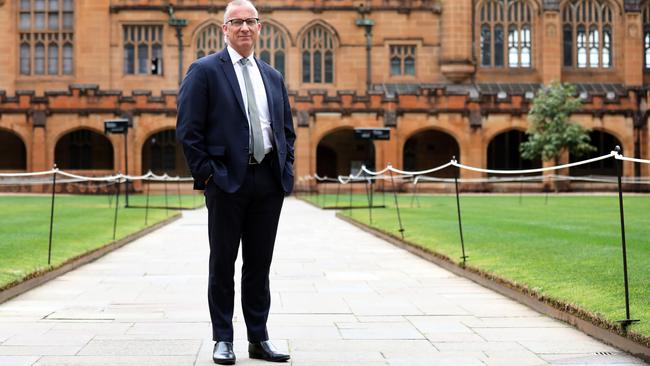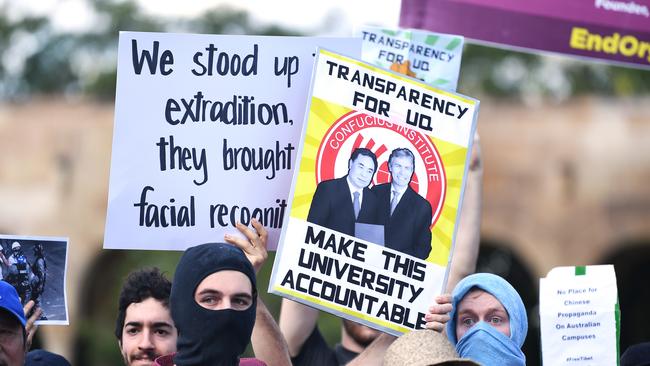Canberra and universities play the politics of risk and reward
The Morrison government and the university sector are trapped in a love-hate stalemate

The university sector, with a foreign student market worth nearly $40bn and sustaining 250,000 jobs, is strategically adrift — trapped between its competing identities as public institutions and educational businesses and plagued by a distrust legacy in its relations with the Morrison government.
The COVID-19 crisis is exposing long-entrenched contradictions in the operations of our universities. University over-dependence on China means reputational damage and balance-sheet risk, the sector’s funding model looks precarious, its entanglement in the culture wars is a blunder and, while universities must be central in the post-coronavirus economy, that pathway remains unclear.
Federal Education Minister Dan Tehan tells Inquirer: “The No 1 priority of the sector must be the education of Australian students. This is the government’s priority. Our biggest challenge will be meeting the impact of COVID-19 on the employment market, which means more demands on the higher education system.”

For any government, this is a non-negotiable goal. But it has been compromised with international students now constituting more than 25 per cent of total campus numbers and 38 per cent at the most prestigious Group of Eight universities, with serious detrimental impacts on local students in tuition and standards. In September last year the Go8 universities had 102,672 enrolments from Chinese nationals comprising 62 per cent of the total foreign component. The number of international students exploded by 100 per cent between 2008 and 2018 in these top universities. The international student market is too big and too rich for Australia to compromise, yet its impact must be managed far better along with the inevitable risk: making Australia hostage to the China market.
“We need to be clear,” Tehan says. “The international market must not take the place of the domestic student market. It cannot be one or the other.” Tehan’s pledge must be seen in context: in recent years international student numbers have grown at twice the rate of Australian student numbers. Recently, more than 70 per cent of the revenue increase for universities came from international students. In Go8 universities 31 per cent of revenue comes from overseas students, as opposed to 23 per cent from government recurrent funding. This trend did not happen by accident — it occurred because successive governments, Coalition and Labor, told universities to find more alternative funding sources.
But there has been a growing cultural divide between the Liberal Party and universities as the institutions have become more corporate and progressive. Liberal MPs often get student feedback about overcrowding, poor teaching and too much ideology. When the government said no to universities getting JobKeeper it was also sending another message — we want you to change. Yet the government is confused. It has treated international students badly during the coronavirus crisis. It needs the export revenue but seems equivocal about the size of the international student component.
The Morrison government, however, signalled on Friday a pathway to allow international students to return to Australia dependent on pre-approval plans from the states. The Prime Minister hoped pilots could be run next month, a potential for Australia to steal another advantage over its rivals in restarting the overseas market.
Tehan seeks to rebuild ties and trust with the university sector. But this is challenged by a legacy of structural funding problems, the impact of COVID-19, managing the financial success of the international student market, the folly of parts of the sector aligning with Labor before the election last year and several tone-deaf vice-chancellors whose dismissal of the free speech debate has alienated government and weakened public confidence in the institutions.
No discussion of the sector is possible without people mentioning outgoing University of Sydney vice-chancellor Michael Spence, whose regular comments and interventions have reached legendary status in their counter-productive folly. Too often in recent years leadership has been lacking on both sides, universities and government.
Public confidence needs to be restored in the operation of the international student market. In relative terms Australia’s universities are more dependent on revenue from Chinese students than any other major country. This week Beijing raised racism claims against Australia — alleging multiple discriminatory attacks against Asians in this country — forcing the Morrison government to reject assertions Australia was an unsafe place.
The irony is that Australia’s superior performance against COVID-19 compared with the competing student markets of the US and Britain might actually drive a lift, not a fall, in Chinese students coming here.
Nevertheless a turning point has been reached — China is ready to use trade retaliation against Australia.
Dependence on China needs correction. But this is easier said than done. Tehan wants a more diverse university sector and a more diversified international student market. His message, by necessity, is cautious. “When it comes to the international student market we want to see universities managing both the benefits and the risks,” he says, an obvious reference to balance-sheet vulnerability.
“If there is too much reliance on one market for the business model then that presents dangers,” he says, an obvious reference to China. “It would be wise for all universities to diversify when it comes to the student market.”
But Tehan stresses the government’s support for the international market, one of our primary export earners, saying “it sustains 250,000 jobs and brings in nearly $40bn in export income”.
The policy and fiscal dilemma arises because foreign student revenue is largely funding university research. This research is pivotal to innovation and the post-COVID-19 economy Scott Morrison wants. Think about it — the government moves against Chinese interference and Chinese investment in sensitive national security areas of the economy but is significantly hostage to Chinese student revenue to deliver the research and innovation essential to the new-look economy.
Go8 chief executive Vicki Thomson tells Inquirer: “We cannot continue to rely on international student fees to prop up our national research system. The Go8 alone is forecasting a revenue decline of more than $2.2bn in 2020, with worse to come in 2021.
“COVID-19 has shone an uncomfortable light on what we have known all along — our funding system is broken with an over-reliance on international fee income to prop up our university research, 70 per cent of which is undertaken in Go8 universities. We have an opportunity for a reset — and that starts with the government having a very clear policy view of what a future Australia looks like.”
The funding system may be broken but there is no solution on the horizon. The budget papers are covered in red ink. There will be no major government funding increase for universities.
The fact senior ministers denied universities access to the JobKeeper scheme, at $70bn the largest emergency package in history, is telling. Tehan acknowledges the structural funding dilemma arising from the cross-subsidy. He tells Inquirer: “I want to work with universities on this. We need to ensure international student revenue is sensibly and prudentially invested so that in any downturn we can protect research funding in this country.” This is important but doesn’t resolve the structural dilemma Thomson identifies.
Former Treasury secretary and now Macquarie University vice-chancellor Martin Parkinson names the post-COVID challenge: “As we rebuild and restructure the economy we will need a higher priority on R&D, science and technology and strengthened business-university research ties. It is unrealistic to expect this can happen if the universities are financially crippled by the loss of international student markets.”
The Go8 wants to use the COVID-19 crisis as a turning point.
Reinforcing Parkinson’s theme, Thomson says: “Never has it been more important that we come together — business, industry, universities and government — to ensure we have a research system which is fit for purpose.”
Tehan says during the crisis he has met elements of the sector on a weekly basis. The government met its main request — guaranteeing the existing $18bn support regardless of any fall in enrolments.
Tehan is pushing a range of initiatives — more diversity so some universities can develop pockets of teaching-only exclusivity, more emphasis on regional and remote education and the successful COVID-19 experiment of discounted six-month short courses, with the sector quickly putting up 320 courses.
The minister agrees with the sector — its role is essential in any successful Australian economic recovery. But there is not yet an agreed long-run strategic approach.
“The Liberals have a psychological problem dealing with universities,” one insider says. “There is a mindset difficulty.”
Parkinson recently organised a letter to Morrison from a group of chancellors — Allan Myers (Melbourne), Belinda Hutchinson (Sydney), Peter Varghese (Queensland), David Gonski (NSW), Catherine Livingstone (University of Technology Sydney), Simon McKeon (Monash), Peter Shergold (Western Sydney), Stephen Gerlach (Flinders) and Parkinson himself — seeking a more direct dialogue on university policy.
The Prime Minister is willing to engage with chancellors but prefers institutional dialogue to be through the minister. But the policy dilemma is acute. The government wants universities to do four things: educate Australian students, meet an international market, fund research and rise up in the global rankings. But there is a shortage of policy and funding instruments to achieve all four goals simultaneously.
Peak lobby group Universities Australia recently commissioned modelling showing the sector could lose $16bn revenue between now and 2023 with losses for the rest of this year put in the $3.1bn-$4.8bn range. “We can’t pretend this won’t have a big impact, chief executive Catriona Jackson says. “We want the government to understand this is not a one-year issue, it’s a two, three and four-year issue.”
Indeed, if the figures are correct this won’t just hit universities — it will have a multiple downward impact on the economy.
Jackson says the peak group has a “good relationship” with Tehan but is “extremely disappointed” to be excluded from the JobKeeper. “In my view a university job is like any other job,” she says. Jackson warns the status quo offers no satisfactory pathway because it means “a substantial portion of Australia’s research is in jeopardy”. She rejects critiques the universities are over-dependent on China to the point of risk. “I find this a surprising argument,” she says, pointing out the substantial revenue and soft-power dividends for Australia. Jackson also rejects criticism that universities should have been ready for a China shock, saying: “I don’t think anyone would have foreseen the COVID-19 crisis. If there is to be a smaller number of international students, then we need to be finding alternative revenue sources for research.”
Long-time higher education analyst Andrew Norton has estimated that universities charge international students 80 per cent more than their teaching costs — by any business model that’s a good deal for the provider. Norton, unsurprisingly, calls this “high” but says it is “consistent with the extreme enthusiasm universities showed for taking even greater numbers of international students and the dire predictions they now make about their finances due to having fewer than expected international students”.
Norton says that by 2018 international student fees provided 26 per cent of all university revenue, up from 10 per cent in 2000, and he judges the international strategy is now doing more than just compensating for the vacuum in government funding.
It is hard to see how this model will be unscrambled unless Beijing takes extraordinary action to terminate the China market. The truth is the university sector is merely the most obvious to the public in the deep trade and services integration between Australia and China.
Meanwhile, it is dubious whether the cultural factors that have afflicted relations between the Coalition and the university sector will be rectified any time soon. Tehan has tried with his commissioning of former chief justice Robert French, who recommended a protection-of-freedom code for universities to buttress free speech and academic freedom.
The French report was a no-brainer yet was treated as a piece of political radioactivity by many vice-chancellors, forcing their chancellors to intervene to endorse the recommendations. Tehan had to go public declaring it was time “for our universities to stand up and defend free speech”. These farcical events revealed the malaise in the sector, its arrogance, ineptitude and politicisation.
French found no crisis about free speech but distinct problems. The saga told the government the sheer extent of university denial and stubbornness. Such impressions have only been reinforced by horror stories about some of the intellectual rubbish being taught in the humanities along with the academic freedom cases involving suspended student Drew Pavlou at Queensland University and the dismissal of academic Peter Ridd by James Cook University.
Tehan tells Inquirer the government will look “very closely” to ensure the French report is implemented this year “in good faith”. He will speak at the National Press Club in the near future on the big picture: the role of higher education in economic recovery.
Despite Tehan’s efforts the questions remain: what exactly does the government want from the universities and what is the policy mechanism to achieve it? Perhaps different ministers have different views.
The answers include being more entrepreneurial, keeping your standards, getting the international market right, looking after Australian students and enhancing our research capacity. It’s a long list.
And there is one certainty — it won’t work unless a stronger partnership is formed between universities and government.




To join the conversation, please log in. Don't have an account? Register
Join the conversation, you are commenting as Logout